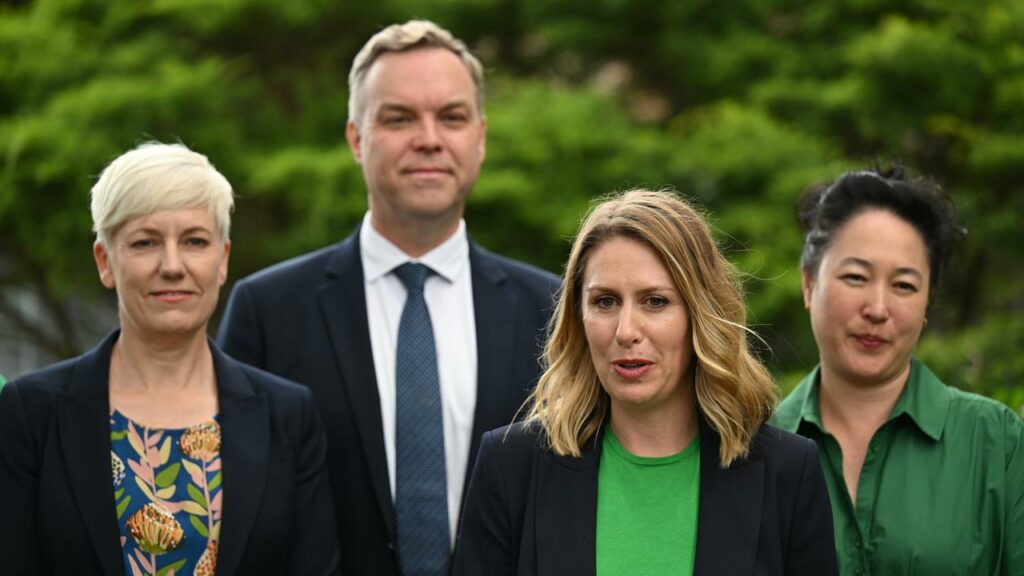NSW Greens looking for lush result at upcoming election
Phoebe Loomes |

As they eye fertile new territory in the regions, the NSW Greens believe they represent more than just the youth vote.
The party has traditionally enticed younger voters with its pro-environment messaging but internal research shows supporters are more often choosing to grow older with the Greens.
“That used to be the situation, where we get a lot of students, people under 25 and lose people in their 30s,” upper house MP and campaign lead Cate Faehrmann tells AAP.
“We’re not doing that so much now.”
Growing loyalty to the Greens brand has been chalked up to both a delivery in nuts and bolts policy areas such as education and housing, and voter disenchantment with the two-party system.
“They recognise we’re not captured by the very interests that they realise are actually wrecking their future,” Ms Faehrmann says.
“We’re still seeing the power of fossil fuel companies and the gambling industry on politics. They’re desperate to support parties that don’t get captured by those interests.”
The party believes it can take three seats in the upper house to increase its total representation to five.
This would include the NSW Greens’ first Indigenous MP in Lynda-June Coe, a Wiradjuri and Badu Island woman.
It’s an achievable result if supporters vote in similar patterns to those recorded at the federal election.
The party is also confident it will retain Newtown, Ballina and Balmain despite the retirement of Jamie Parker in the inner western Sydney seat.
After analysing voting patterns at council elections and running years-long local campaigns, the party has ambitions to pick up support in the regional seats of Lismore and South Coast.
“Both of those electorates have been on the frontline of the climate crisis in different ways, with floods and fires,” Ms Faehrmann says.
But expectations of fertile green plains have been torched by polling analyst Kos Samaras, who expects a modest result in which the party retains its existing seats.
The two-party system remains a significant hurdle for the Greens, who struggle to push themselves over the line.
“Their vote is pretty big but it’s nowhere near Labor’s primary vote,” Mr Samaras says.
This played out at the last election in the Sydney seat of Coogee, where the Greens secured 14.5 per cent of first preferences in 2019, losing to Labor’s 34.4 per cent.
“I expect them to hold on to Ballina, Balmain and Newtown,” Mr Samaras says.
One year on from the catastrophic and deadly Lismore floods, the Redbridge Group director says the Labor-held seat could fall to the minor party.
With the Northern Rivers city hampered by red tape, Greens candidate Adam Guise says community anger continues to simmer.
“Superficially we’ve cleaned up the streets but there’s a lot of angst and concern out there about our futures going forward,” he says.
Mr Guise had to be rescued from a roof during the Lismore floods and saw his own home destroyed during the disaster.
He is now renting.
“People are really suffering,” he says.
Local flood survivors are angry with the state government after its delivery of recovery packages slowly dried up.
“They made promises early on in the flood that the purse strings would be open and no money would be spared in helping us but that action has kind of petered out,” Mr Guise says.
“People have been left on their own and reliant on community organisations.
“There’s been a severe lack of communication from the government about the way forward.”
Mr Guise says the $800 million Northern Rivers Reconstruction Corporation, co-funded with the federal government to remediate homes damaged by inundation, is a “big, slow bureaucracy” failing to communicate with the public.
The government announced the authority in November last year, with Premier Dominic Perrottet saying it “cuts through red tape, cuts through bureaucracy” to get communities back on their feet.
However, a community rally was held outside its headquarters last month, with Lismore locals complaining it was still unclear whether they were eligible for buybacks or land swaps, or if their homes could be moved to safer ground.
As community frustration stews, Mr Guise reckons the Labor-held seat is winnable for the Greens.
“There’s only a very small margin between the Greens and Labor,” he says.
“People certainly want change.”
The Greens’ successful federal election campaign, which resulted in three new MPs, was dubbed a “Greenslide” and largely credited Queensland MPs with running a grassroots campaign focused on door-knocking and speaking to voters.
But going to the source has a longer history in the NSW Greens.
“Our people-powered campaign that won the seat of Newtown and Balmain happened well before the Greenslide in Queensland,” Greens MP and member for Newtown Jenny Leong says.
“When you go out and you knock on people’s doors and you listen to them, not only do they feel heard but it improves me as a representative.
“The Greens have had that connection to grassroots community for decades.”
Ms Faehrmann agrees extensive, years-long doorknocking campaigns have delivered an edge in numerous campaigns, adding some successful MPs have “knocked on every door in that electorate”.
But demographics will have a far greater impact on the party’s vote than visiting local neighbourhoods at the upcoming election, Mr Samaras says.
Greens voters are predominantly millennials and zoomers, under the age of 40. They usually rent and have a tertiary education, he says.
“Wherever younger voters are being pushed because of the rental situation in Sydney, you’ll find that that will have an effect on the Green vote in a positive way.”
AAP


